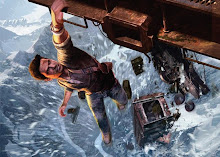Due to the popularity of The Art Behind Uncharted 2 and The Art Behind Battlefield Bad Company 2 I have made put together this one on God of War III. This one however is much more in-depth and therefore does get a bit technical. I have tried to keep it simple for anyone to read but at the same time offer quality information for those looking into creating games.
Let me start by saying God of War III is an amazing game; it not only looks amazing but it plays fantastically as well. If you haven’t played it go out and get it, you won’t be disappointed.
God of War III can easily be considered as the greatest looking console game of all time, maybe even across all platforms. Its huge scale and extensive amount of detail produce a breathtaking display of awesomeness. This article will show and discuss how Santa Monica Studio managed to raise the bar in video game graphics.

Traditional art skills are still very much key in creating games and maybe even more so these days as more detail is needed. Programs such as ZBrush allow game artists to virtually sculpt their models on the computer, anatomy plays a major role in the designing of characters and creating believable animations. Without traditional art skills you cannot become a games artist. Luckily for Santa Monica Studio they have some very good talent in their team.
During the game design process the entire art department is linked together. For example the Art Director tells the Concept Artists what he/she wants and the Concept Artists create image references that then go to the Environment Artists who then work with the Level Designers etc. Complete team collaboration is essential and although GOW 3’s development team was around 130 people, these people worked together and created an epic experience.
PS3 technology has really increased the scale of the game. GOW1 and 2 used a lot of smoke and mirrors but GOW 3 does not. A good example of this is the huge titans that in previous versions of the game only a busk of the titan was used and some animation however in GOW 3 the titans are fully their and interactive.
To get this kind of scale and improvement in graphics more effort is required so bigger teams are hired. For example for GOW 2 the cinematic environment team consisted of just one person, on GOW 3 it moved up to 8 people.
The picture below shows a texture map of a dead man’s face. This image is then placed onto the model inside of Maya and then rendered in the game:
Where would the world be without Photoshop eh?
Autodesk Maya is main tool used in creating 3D models for God of War. It is used to create the basic shape of objects which are then taken into ZBrush to add detail to the object, such as scratches. This video below shows how detail is sculpted into the 3D models using ZBrush after they have been made in Maya:
Autodesk Maya is used to create the games 3D models and also the games animations, whether that is for Kratos or for particle effects. The images below show how Kratos' path is set out on a titan:
Below are images of an article which interviews some of the key Santa Monica Studio’s art team. It is a very insightful read that outlines the enormous amount of work that was put into God of War III:
Here are some in-depth videos on the art of GOW 3, however be warned they do include SPOILERS:
For more great behind the scenes look at God of War III I recommend you check out this play list on YouTube http://www.youtube.com/watch?v=lttd7a7qKBY
God of War III is without a doubt a fantastic achievement in video game creation, setting the bar higher for all games to follow. If you are yet experience this game then you are truly missing out on a classic.




















"GOW1 and 2 used a lot of smoke and mirrors but GOW 3 does not. "
ReplyDeleteconfirms you don't even know what you are talking about:/ And I bet half of what you say in this article are bullsh:/
do you know what smokes and mirrors are? it's basically a way of lying or deceiving people.
"For example the Art Director tells the Concept Artists what he/she wants and the Concept Artists create image references that then go to the Environment Artists who then work with the Level Designers etc. Complete team collaboration is essential and although GOW 3’s development team was around 130 people, these people worked together and created an epic experience."
nor!!!! as if we wouldn't know. Thanks for educating us.
Alan wake used the motion blur effect to hide the framerate glitches...u can call that a smoke and mirror effect..may be he meant something like that for gow1 and 2?
ReplyDelete@xino
ReplyDeleteYou are spot on with you description of the smoke and mirror effect and if you read on I gave an example of that effect in the GOW 2, let me brake it down for you - In GOW 2 as they did not have the raw processing power they could not build full scale titans for in game gamplay, so they only built the head and the hide where the body would be behind a mountain or a resricted camera angle so that the player could not see that only half a titan/ big boss existed, in Gow 3 they had the power and could fully create the titans without deceiving the player.
I hope you can actually understand now and as for your other comment some people do not know the basic work flow of a games company and it is always good to remind those who do so that they have a beeter understanding of the article as a whole and how the game was put together.
asdasd
ReplyDeletecam sexLondon escorts
ReplyDelete